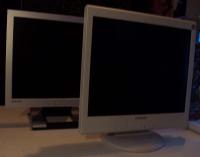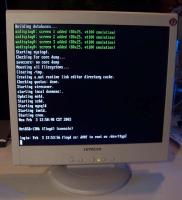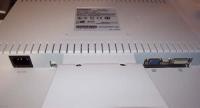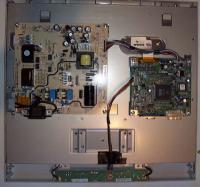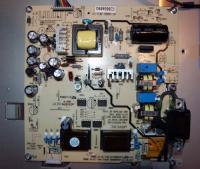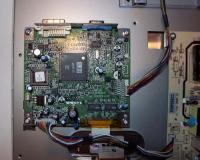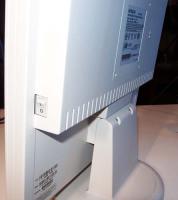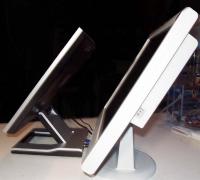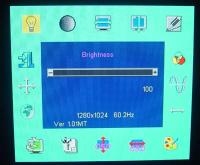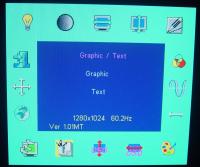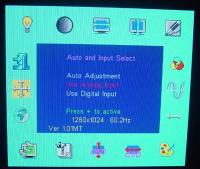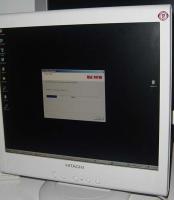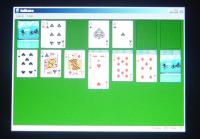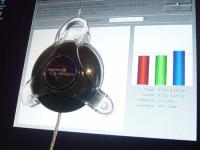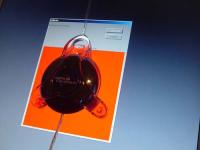
Original Link: https://www.anandtech.com/show/1068
Hitachi CML174 17'' LCD Plus Samsung 172T Revisted
by Kristopher Kubicki on February 12, 2003 3:24 AM EST- Posted in
- Displays
Introduction
We took a look at the Samsung 172T last week and we were very pleased with the final product. Unfortunately, even for all its grandeur, we were not impressed about the 25ms response time. Even though we did some rudimentary gaming tests to look for shadows or 'trails' in the image, we already knew most gamers would automatically reject purchasing the 172T without that magic sub-20ms performance specification. Since Samsung will not have an ultra-low response time LCD for at least 5 more months, everyone wants to know who the current gaming LCD champion is going to be.
Enter Hitachi.
Hitachi has gone through quite a wild ride
over the last few years. They were one of the first producers of LCD’s and
everyone marveled at some of their first and second generation production
facilities. However, as economic troubles erupted in
Needless to say, the outlook on Hitachi display technology has looked bleak. They stopped production on all CRT's a year ago and dedicated themselves to only LCD production. But how did they plan on stealing the attention away from the number one and number two producers of LCD substrates? By going to the number three producer of LCD screens, of course, AU Optronics. AUO, if you are not familiar, is a merger of Acer Display and Unipac Optoelectronics. Currently, AU Optronics produces the only 16ms response time LCDs on the market. Therefore, every 16ms LCD on the market right now will be some sort of variation on the same AUO screen. The Hitachi CML174 leads the pack in 16ms response time LCDs as far as popularity, but it should be mentioned that the Eizo and ViewSonic 16ms monitors are also manufactured with the same AUO panels. To briefly address the questions to those in our forums; there is no 16ms version of an 18'' or 19'' version of this panel yet, so we are limited to the smaller 17'' versions until large scale production begins on the bigger screens. (Samsung stated to us that they will be implementing their low response time technology on the larger monitors and working their way down instead).
Hitachi has longed for a product to steal the spotlight and right now it looks like they have just that. Gamers and enthusiasts alike have praised the CML174SXW for several weeks now. Rather than rush a review of this product, we decided to take our time and take a very thorough look at the most popular LCD available right now. Get ready as we examine every inch of the CML174.
Construction
If you have been keeping track of our previous LCD reviews, you will know that we have spent a small amount of time mocking the lack of color choices for monitors on the market right now. Many of you will be happy (or unhappy?) to know that the Hitachi CML174 does NOT come in silver. Our particular unit came in white, but Hitachi also sells a black version as well.
Interestingly enough, the CML174 has a very narrow bezel along the left and right sides, which provides the optical illusion of a larger screen. The bezel width is approximately 2/3 the size of the Samsung 172T's vertical bezel, but the CML174 stretches several times the depth of the Samsung panel. Because the connectors are mounted on the bottom of the 172T, the footprint on the CML174 takes up approximately 2” less desk space (in terms of depth) than the 172T.
While starting a new LCD up, we first look for dead pixels on the screen. Some screens will often have a dead sub pixel, meaning one of the 3 components of a single pixel will be stuck in an on or off position. However, if all three subpixels are broken, most companies (including Hitachi) now have a dead-pixel warranty. The CML174 also ensures a warranty on 6 dead subpixels, meaning if you can find 6 dead subpixels on the screen you get the same warranty if one full pixel was broken.
Our forums literally exploded last week when we announced that we would be exhaustively examining the CML174. This is the first monitor produced on a substrate with a low enough response time to appeal to gamers. While looking at the monitor specifications, we can conclude that the CML174 and the Samsung 172T differ in only a few key specifications.
| Samsung SyncMaster 172T |
|
| LCD |
17”
a-Si TFT/PVA LCD (Active Matrix) |
| Scanning Frequency |
Horizontal: 30-81kHz (analog) |
| Response Time |
25ms (Typical) |
| Contrast Ratio |
500:1 (Typical) |
| Compatibility |
1280 x 1024 (Native) |
| Brightness |
250 cd/m2 |
| Dimensions (WxHxD) |
15.2'' x 15.6'' x 8.5'' |
| Power |
Working : 42W Max |
| Weight |
10.3lbs |
| Warranty |
3 years parts and labor |
| Hitachi CML174 |
|
| LCD |
17”
a-Si TFT LCD (Active Matrix) |
| Scanning Frequency |
Horizontal: 24-80kHz |
| Response Time |
16ms (Typical) |
| Contrast Ratio |
400:1 (Typical) |
| Compatibility |
1280 x 1024 (Native) |
| Brightness |
260 cd/m2 |
| Dimensions (WxHxD) |
15.5'' x 14.7'' x 8.0'' |
| Power |
Working : 48W Max |
| Weight |
11.0lbs |
| Warranty |
3 years parts and labor |
Immediately, you should note that the CML174 has the famed 16ms response time
with a slightly higher brightness rating (260nits versus 250nits) but the
Samsung has a much higher contrast ratio. We will explore the unique qualities
about these two units near the end of the review.
The other key difference between these two monitors is the response time. There have been dozens of claims that this response time will result in a better gaming and entertainment experience, but we would sure like to verify it. We have provided several gaming experiences with both the CML174 and the Samsung 172T in the benchmark of this review.
Since the Hitachi CML174 had exposed screws (most LCD's we have seen do not), it was almost too tempting to take a look and see what was under the hood. If you look closely, you will see that Hitachi really does prove there are a million uses for duct tape.
The larger beige board handles the DC step down conversion and provides power for the components.
The smaller green board interfaces the inputs, controls and power together on the LCD screen. The large Genesis chip handles analog to digital conversion, while the smaller chip labeled “REV1.01MT” handles the on screen display. (Notice in our OSD section that a small Rev 1.01MT appears in the lower left hand corner of the menu). Very close inspection will reveal that AU is clearly written on the ribbon connecting the interface board to the LCD itself.
Features
Sadly, the CML174 does not have all of the neat space features found on the Samsung 172T. When we first opened the packaging our original impression was that this would be a no frills monitor.
The most notable feature we see from the pictures inside includes an integrated DC converter. This adds to the bulk of the monitor but clears a lot of clutter from already stressed workspaces. The CML174 produces a slightly higher amount of heat emissions compared to the 172T and other monitors we have looked at, but the tradeoff seems to be worth it. The fact that the CML174 has a slightly higher working power requirements may be due to the fact that the onboard DC converter may not be as efficient as the traditional “brick” unit found on the 172T. We noticed similar phenomena on the Daewoo L700C which also had an integrated DC converter. We should also note that the heat generated by the monitor emits primarily from the bulky rear panel rather than the sides of the bezel like the 172T.
Hitachi mounted the screen on a round plastic base, but the base does not swivel. Unlike the Daewoo and Albatron LCD’s we looked at, the CML174 does not employ any sort of counter weighting on the base. Since the DC circuitry resides on the monitor itself, the CML174 is a very top heavy display. Even though the base provides a very sturdy platform, do not expect the easy free movement of the Albatron L17AT.
The CML174 tilts only 30 degrees, although this should be plenty for most users. The CML174 is not nearly as flexible as the 172T, and unfortunately requires an additional arm to be wall mounted.
On Screen Display
Over the last few display reviews we stressed the importance of clear easy to understand OSD’s. The CML174 resorts to a very traditional button layout for their menu interaction. From left to right, the buttons are as follows; “Auto/Left adjust, Right Adjust, Power, Function Left, and Function Right.” The menu is brought up by hitting one of the directional function keys.
We concluded that the menu was far from perfect when we noticed that the icons were laid out in a circular, rather than linear fashion. The buttons should really be considered counterclockwise and clockwise rather than left and right (although the illustrations on the monitor might disagree). The problem occurs at the bottom of the menu when one has to use the “Left” function key to move to the right.
Other surprises included the “Graphic/Text” feature in the menu. The menu option displays a Graphic/Text, Graphic or Text option which we assume allows the user to specify which display preset is currently on the screen. However, this feature never appears to be selectable.
The Auto feature performed on par with other LCD’s we looked at. The CML174 and Samsung 172T were both able to synchronize their screens in the same amount of time, and neither produced incorrect image adjustments. Neither of these monitors hides the Auto feature only inside the menu, as it can be accessed as a shortcut from the primary buttons on the monitor. Unfortunately, switching inputs on the CML174 requires four to five keystrokes. Our other opinions about the OSD may have been aesthetic, but burying the input selection that deep inside the menu hurts our general opinion of the menu on the CML174.
Benchmark
For comparison purposes, we ran a combination of CheckScreen, DisplayMate and VESA's Flat Panel Display Measurements Handbook (2.0) on the Hitachi CML174 against the previously reviewed Samsung 172T. Below is a table with the tests performed and notes we made during testing. Our test machine is composed of an Inno3D GeForce4 4200 using the VGA 15 Pin D-sub as well as the DVI connections. We ran all of the tests at 1280x1024 pixels with a refresh rate of 60Hz. Before the final benchmark, we calibrated the monitor as per the instructions included with DisplayMate; any changes to the LCD during the initial calibration run are noted in the observations. Response time benchmarks will be reported on the second page of our examination.
If you read our previous 172T review, you will see that we changed our traditional benchmark to represent a quantitive, rather than subjective, scaling system (5 is the best rating, while 0 is the worst). Recently, the folks at NEC and VESA were able to introduce us to some new benchmarking techniques which we will also be attempting. If you are familiar with the VESA FPDM2 you will know that this is a very thorough and complex document, but it does provide lots of excellent technical information on LCD displays.
| DisplayMate/CheckScreen/VESA FPDM 2.0 |
||
| Test |
Monitor |
Observations |
| Intensity range check |
172T (digital) |
5, Looks good |
| 172T (analog) |
5 |
|
| CML174 (digital) |
4.5, close but slightly too bright |
|
| CML174 (analog) |
4.5 |
|
| Black level adjustment |
172T (digital) |
4, Black levels still slightly high |
| 172T (analog) |
4 |
|
| CML174 (digital) |
3.5, blacks lighter than on the 172T |
|
| CML174 (analog) |
3.5 |
|
| Defocusing, blooming and halos check |
172T (digital) |
5, None |
| 172T (analog) |
5 |
|
| CML174 (digital) |
5, None |
|
| CML174 (analog) |
5 |
|
| Screen uniformity and color purity |
172T (digital) |
5, Uniform |
| 172T (analog) |
5 |
|
| CML174 (digital) |
4, large bright patch present in lower half of screen |
|
| CML174 (analog) |
4 |
|
| Dark screen (Glare Test) |
172T (digital) |
4, slight glare |
| 172T (analog) |
4 |
|
| CML174 (digital) |
4, slight glare |
|
| CML174 (analog) |
4 |
|
| Primary colors |
172T (digital) |
4, unscaled hues display fine, but not perfect. |
| 172T (analog) |
5 |
|
| CML174 (digital) |
3.5, problems with achieving all colors correctly |
|
| CML174 (analog) |
4.5 |
|
| Color Scales |
172T (digital) |
3, Still difficulty with reds, although an improvement over the 191T |
| 172T (analog) |
4 |
|
| CML174 (digital) |
2, severe color inaccuracies, even after recalibration |
|
| CML174 (analog) |
3 |
|
| 16 intensity levels |
172T (digital) |
4, Good, but not perfect |
| 172T (analog) |
4 |
|
| CML174 (digital) |
3.5, problems with red |
|
| CML174 (analog) |
4 |
|
| Pincushion/barrel distortion |
172T (digital) |
5, None |
| 172T (analog) |
5 |
|
| CML174 (digital) |
5, None |
|
| CML174 (analog) |
5 |
|
| Geometric Linearity |
172T (digital) |
5, no curvature |
| 172T (analog) |
5 |
|
| CML174 (digital) |
5, no curvature |
|
| CML174 (analog) |
5 |
|
| Focus check |
172T (digital) |
5, Uniform Focus |
| 172T (analog) |
5 |
|
| CML174 (digital) |
5, Uniform |
|
| CML174 (analog) |
5 |
|
| Horizontal color registration |
172T (digital) |
5, Level |
| 172T (analog) |
5 |
|
| CML174 (digital) |
5, Level |
|
| CML174 (analog) |
5 |
|
| Vertical color registration |
172T (digital) |
5, Level |
| 172T (analog) |
5 |
|
| CML174 (digital) |
5, none |
|
| CML174 (analog) |
5 |
|
| Fine line moiré pattern |
172T (digital) |
5, None |
| 172T (analog) |
5 |
|
| CML174 (digital) |
5, none |
|
| CML174 (analog) |
5 |
|
| Screen regulation |
172T (digital) |
5, no problems |
| 172T (analog) |
5 |
|
| CML174 (digital) |
5 |
|
| CML174 (analog) |
5 |
|
| Streaking and ghosting |
172T (digital) |
5, none |
| 172T (analog) |
3, streaking present, but expected |
|
| CML174 (digital) |
5, none |
|
| CML174 (analog) |
3, similar to 172T |
|
Before getting too far into our analysis of the benchmark, we would like to take some time to explain the three most misunderstood terms we use in our benchmarks. We will start with 'trailing' also know as 'shadowing' or 'motion blur.' This phenomenon is the reason why people demand low response time LCDs and only occurs on LCD's. The problem occurs when the individual LCD pixels takes several milliseconds to turn off after turning on. The result is a sort of “ghost” that follows the actual image.
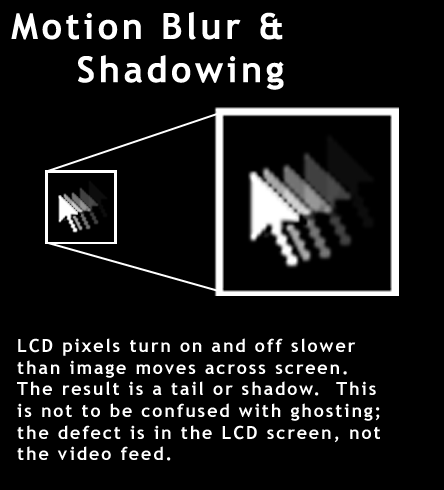
However, do not confuse this with ghosting! Ghosting, (official described by VESA as cross coupling), occurs when an image produces a sort of copy of itself over an existing image. This defect is the result of interference and is not limited to LCDs.
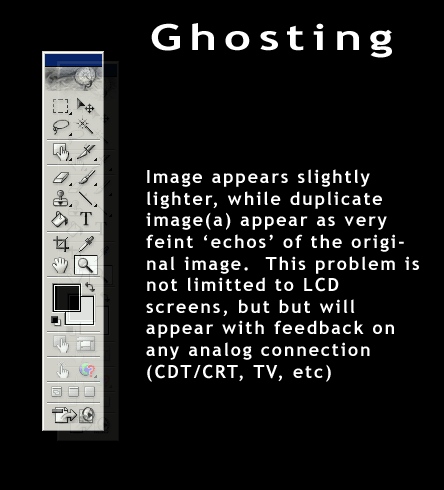
Streaking is the hardest defect to describe, but the image below should provide a quick and easy visual reference. Briefly stated, it is the creation of artifacts on contrasting color schemes. Again, this problem is not dependant on LCD screens, but occurs on TV's, CRTs, etc. In fact, it will occur on any connection that is dependant on an analog signal. When a signal travels along an analog connection, the cabling behaves much like an antenna, corrupting the VGA signal.
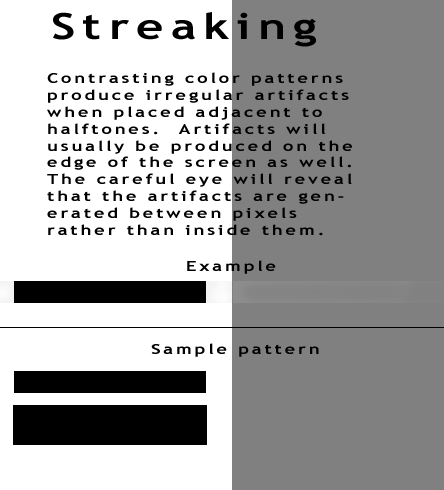
As we can see from our benchmark, streaking on the analog connection proved very problematic. Just by reading white text on a black background, we saw waves inside the text similar to fine Moiré. If you plan on buying this monitor, we highly encourage the use of a DVI connection. We have stressed with several other reviews that analog just does not cut it for LCD's, and it is really a shame that 15-pin analog connections persist even today. If you have not seen our other complaints about the Digital to Analog back to Digital process before, please refer to the Daewoo L700C review we did several months ago.
Overall, our first impressions on this half of the benchmark were not as competitive as we had expected. Our largest complaint was in screen uniformity. We noted in our review of the Daewoo L700C that there were distinctive light patches along the edges of the screen. These patches are caused by the backlights shining unequally across the rear of the panel. On the CML174, the bottom of the LCD produces a slightly brighter image than the other sides of the LCD. We mentioned earlier that the screen employs a combination of 4 CCFLs (cold cathode florescent lights) to produce backlight for the monitor. We would accredit the lack of uniformity to a non-traditional positioning of the backlights to produce an offset in uniformity.
Screen uniformity is very important. In the world of art, and display technology, the brightest bright and darkest dark are the two areas that the eye immediately focuses on. On the Hitachi CML174, the eye drifts from the center of the screen to the lower center portion of the monitor because this area produces a slightly lighter image than the rest of the screen. That being said, we should also point out that the Samsung 172T produces one of the most uniform screens we have seen to date, and really stomps all over the CML174 in this category.
The color rendition tests proved very mediocre as well. Our standards have increased after seeing products like the 172T, but we can easily identify problems when we have one LCD next to the other. Like the 191T from July, the CML174 has a real hard time with intense shades of green and red. While doing the benchmark, we continually readjusted the brightness and restarted to produce the correct tones instructed by DisplayMate. While several sources insist the brightness should be turned all the way down, we determined the sweet spot for (almost) accurate color replication lies in the 30 – 50% range. We can actually determine why by mathematically analyzing the specifications given to us; contrast ratio and brightness.
Contrast Ratios and You
Unfortunately, screen uniformity was not the only category that Samsung took the crown. The CML174 has a slightly higher brightness rating, but lacks a high contrast ratio. There are several immediate effects for this, which explain the problems with vivid color reproduction on the CML174.
Basically, to calculate the contrast ratio, the values of the darkest black and the lightest white are first obtained. The ratio of the light over the dark value produces a fraction which is then reduced to a whole number. Even though the measurement may be simple, the specification itself is not. VESA publishes at least six different methods of obtaining contrast ratio measurements. To further complicate matters, some manufacturers decide to take off angle measurements (to reduce glare) or darkroom measurements. For example, some monitors might state they have a 500:1 contrast ratio at 5 degrees.
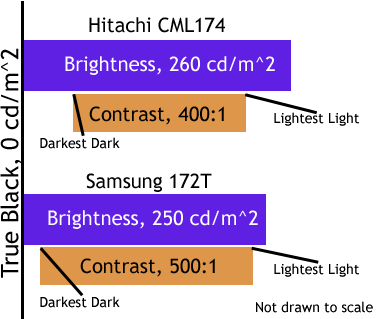
Even though contrast ratio and brightness are not dependant on each other, they do work measure similar qualities. We can imagine the brightness (luminance) as the upper bound on a contrast ratio, and crudely illustrate the color depth of an image inside that contrast ratio. If a color is allowed more depth in light and dark values, it produces more vibrant tones. Essentially, this generates less strain on the eyes (try reading white text on grey paper). For a gaming LCD, we definitely would have enjoyed a higher contrast ratio on the CML174.
Some people reading this may ask why there are no contrast ratios for CDT/CRT’s. Simply put, LCD’s need a light source shining behind the pixels at all times, even to produce just a single white pixel. A traditional CRT differs by dimming the electron gun behind a certain pixel to produce black. True black on a CRT produces a luminance of near zero. By dividing the lightest light by the darkest dark luminance values (cd/m^2) on a CRT, one might conclude the contrast ratio would equal infinity. Sales teams attempting to explain a specification of infinity do not typically agree with the marketing representatives in most companies. (If you are number two in the sector you may have to start marketing the contrast ratio as infinity+). Thus, for CRT’s the measurement becomes irrelevant.
The higher contrast ratios provide a quick reference for how vivid colors might appear on the screen, but we have to keep in mind that it requires brightness measurements as well. The VESA FPDM2 handbook jokingly portrays a cartoon stating something along the lines of “Well it says 102:1 contrast ratio but it certainly looks better than that!” Unfortunately, contrast ratios are a flawed and unreliable measurement, but the LCD sector depends on it too much for it to be removed from screen specifications.
Gaming on the CML174 – Response Time
Without sensitive light meters we are somewhat resorted to the unfortunate analysis of just looking at the image while playing some high intensity games. We say unfortunate because this benchmark becomes more psychological than metrological. Simply knowing that the CML174 does or does not have a quick response time would skew a visual examination of the unit. That being said, we are still going to take a look at a few games and give our impression between the Samsung 172T and the Hitachi CML174.
Max Payne
The contrasting light and dark images in Max Payne make it great for testing LCD's on. If anyone has turned the brightness way up on the black maze levels they will know it becomes real easy to tell where to walk. On the CML174, even after adjusting our monitor brightness to the sweet spot described in the benchmark, we could too easily distinguish platform from pitfall during the black mazes. The Samsung 172T provided a much larger challenge, although still not perfect. Other mentionable observations include intense streaking on the analog connections for both of these monitors. DVI looked great on both; no streaking, no ghosting.

Digital photo, not screen shot
MechWarrior 4 Mercenaries
Slightly faster paced than Max Payne, MW4M demonstrates a lot of fast, light on dark motion. The 172T demonstrated its inability to keep up with 90fps rockets fairly early in the game. The 172T did alright on the Max Payne test, but some of the arena battles in MW4M began to stress our patience. Objects that tended to change direction rapidly such as fragments bouncing off a wall were the most disorienting. Objects like lasers that do not change direction where not nearly as detectable. That being said, the CML174 showed the most of its domination right here. We still noticed a small amount of blur when analyzing the screen very closely, but we came to the consensus that the CML174 demonstrated a much better fast motion experience.
UT2003
Combining fast motion and color rendition, UT2003 lays somewhere in between Max Payne and MW4W. The color handicap on the CML174 became strikingly apparent on some of the greener arenas where we continually had the feeling that everything had a bluish hint to it. Even though it did not affect game play, we had the impression that we were not seeing the original screen as the creators wanted us to see it. The 172T performed great, but we again noticed some problems with objects changing directions rapidly. Turning rapidly back and forth puts a soft blur around most edges.
Solitaire
Looks good.
DVD playback
We saw surprisingly little difference from one monitor to the other. As expected, our DVD of Men in Black II looked pretty much the same on both screens, while The Matrix demonstrated a very small difference in high motion. DVD (and most other video sources) display video at approximately 30 frames per second or less. Thus, the screen displays each frame for approximately 33ms. Even with a poor response time of 15ms rising and 15ms falling we should notice very little motion blur. The CML174 came close, but could not produce the same rich colors from the 172T.
Even though we could not scientifically test the response times with any accuracy, we noted that the CML174 appeared sharper during high intensity motion. This makes sense because the lower response time assures leading and trailing edges of an object manifest themselves faster. We were a little surprised that DVD playback did not seem to be as dependant on response time as gaming, but after inspecting the logic we concluded that this should have been expected.
Sneak Peak – ColorVision Spyder
We have received lots of positive feedback about our LCD reviews. To further better our benchmarks and analysis of new products, we recently received a Spyder and OptiCAL software from ColorVision. Unfortunately, we received the calibrator only hours before this CML174 review was slated to post on the website. We took a few preliminary tests and calibrations with the Spyder, and we are anticipating using it to more accurately test our monitors in the future! Here is a quick look of some screenshots.
Hitachi CML174 calibration with PreCAL
Profiling with OptiCAL
Sample readout of the CML174 and Samsung 172T respectively (DVI connection)
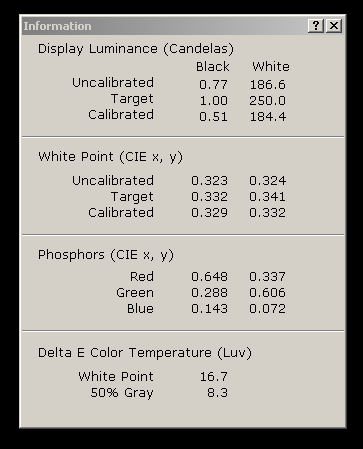
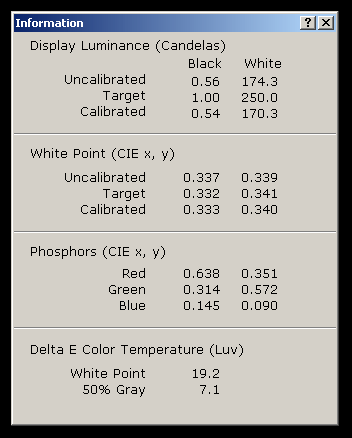
Conclusions
Overall we were conflicted about some of the performance benchmarks on the CML174. We were a little disappointed to verify that there were some problematic color rendering problems. In essence, similar accuracy problems that plagued the 191T seem to occur in this display as well. Whereas Samsung has spent several months correcting color problems on their own production facilities, will AUO do the same for Hitachi?
Our look at gaming on the CML174 was not 100% conclusive, as we still detected the type of blurring the 16ms response time was supposed to eliminate. After a whole lot of MechWarrior 4, Max Payne and UT2003, we still concluded the CML174 blurred less on high motion objects. Until a standardized benchmark for measuring response time becomes available, we will continue to rely on a subjective test.
Obviously, the most deciding factor for many buyers will be the price. The CML174 pulls ahead of the 172T costing a little more than 50USD less than the 172T on the street. Monitors Direct offers the same unit we reviewed in black or white for 575.01 USD, free shipping plus advance placement warranty.
The hype surrounding this monitor seems to be worth it. The CML174 and the Samsung 172T are both excellent monitors, but after thoroughly examining both we came to the conclusion that they are more like apples and oranges. The Samsung 172T provides stronger and more vivid colors, along with great style and OSD. The Hitachi CML174, on the other hand, has an integrated DC converter, lower response time and lower price. We would not recommend the CML174 for graphic designers just yet because of some of the color rendition problems present. For gaming, AUO/Hitachi really did an excellent job. It may not be the most attractive or stylish unit on the market, but it does what it says, and it does it well.
Furthermore, we can call the CML174 unique as it is the first of its kind. Once manufacturers like LG and Samsung see the demand created by the CML174 and other 16ms response time monitors, a competitive battle over the gaming market should ensue. From our interview with Samsung, it looks like they are about 5 months behind, and we will not see on of their low response time units until late Q2 or early Q3. Kudos to both Hitachi and AUO for finally opening LCD’s to gamers.
Special thanks to Hitachi Displays for providing us with a review sample of the CML174. Many thanks also to NEC and Samsung for recently providing us with enough technical documentation to squish an elephant.

